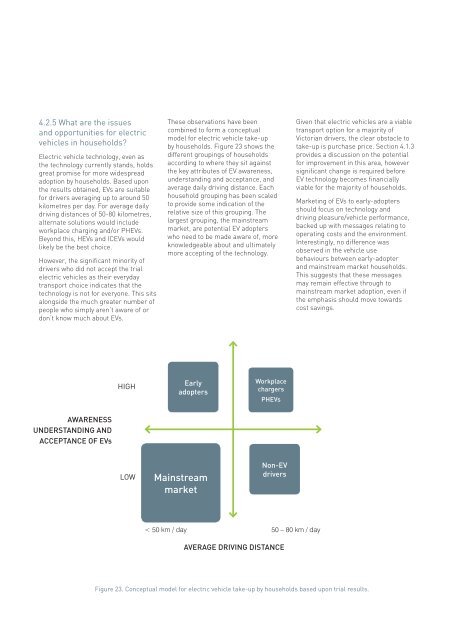victorian electric vehicle trial mid-term report - Department of Transport
victorian electric vehicle trial mid-term report - Department of Transport
victorian electric vehicle trial mid-term report - Department of Transport
- No tags were found...
You also want an ePaper? Increase the reach of your titles
YUMPU automatically turns print PDFs into web optimized ePapers that Google loves.
4.2.5 What are the issuesand opportunities for <strong>electric</strong><strong>vehicle</strong>s in households?Electric <strong>vehicle</strong> technology, even asthe technology currently stands, holdsgreat promise for more widespreadadoption by households. Based uponthe results obtained, EVs are suitablefor drivers averaging up to around 50kilometres per day. For average dailydriving distances <strong>of</strong> 50-80 kilometres,alternate solutions would includeworkplace charging and/or PHEVs.Beyond this, HEVs and ICEVs wouldlikely be the best choice.However, the significant minority <strong>of</strong>drivers who did not accept the <strong>trial</strong><strong>electric</strong> <strong>vehicle</strong>s as their everydaytransport choice indicates that thetechnology is not for everyone. This sitsalongside the much greater number <strong>of</strong>people who simply aren’t aware <strong>of</strong> ordon’t know much about EVs.These observations have beencombined to form a conceptualmodel for <strong>electric</strong> <strong>vehicle</strong> take-upby households. Figure 23 shows thedifferent groupings <strong>of</strong> householdsaccording to where they sit againstthe key attributes <strong>of</strong> EV awareness,understanding and acceptance, andaverage daily driving distance. Eachhousehold grouping has been scaledto provide some indication <strong>of</strong> therelative size <strong>of</strong> this grouping. Thelargest grouping, the mainstreammarket, are potential EV adopterswho need to be made aware <strong>of</strong>, moreknowledgeable about and ultimatelymore accepting <strong>of</strong> the technology.Given that <strong>electric</strong> <strong>vehicle</strong>s are a viabletransport option for a majority <strong>of</strong>Victorian drivers, the clear obstacle totake-up is purchase price. Section 4.1.3provides a discussion on the potentialfor improvement in this area, howeversignificant change is required beforeEV technology becomes financiallyviable for the majority <strong>of</strong> households.Marketing <strong>of</strong> EVs to early-adoptersshould focus on technology anddriving pleasure/<strong>vehicle</strong> performance,backed up with messages relating tooperating costs and the environment.Interestingly, no difference wasobserved in the <strong>vehicle</strong> usebehaviours between early-adopterand mainstream market households.This suggests that these messagesmay remain effective through tomainstream market adoption, even ifthe emphasis should move towardscost savings.HIGHEarlyadoptersWorkplacechargersPHEVsAWARENESSUNDERSTANDING ANDACCEPTANCE OF EVsLOWMainstreammarketNon-EVdrivers< 50 km / day 50 – 80 km / dayAVERAGE DRIVING DISTANCEFigure 23. Conceptual model for <strong>electric</strong> <strong>vehicle</strong> take-up by households based upon <strong>trial</strong> results.
















